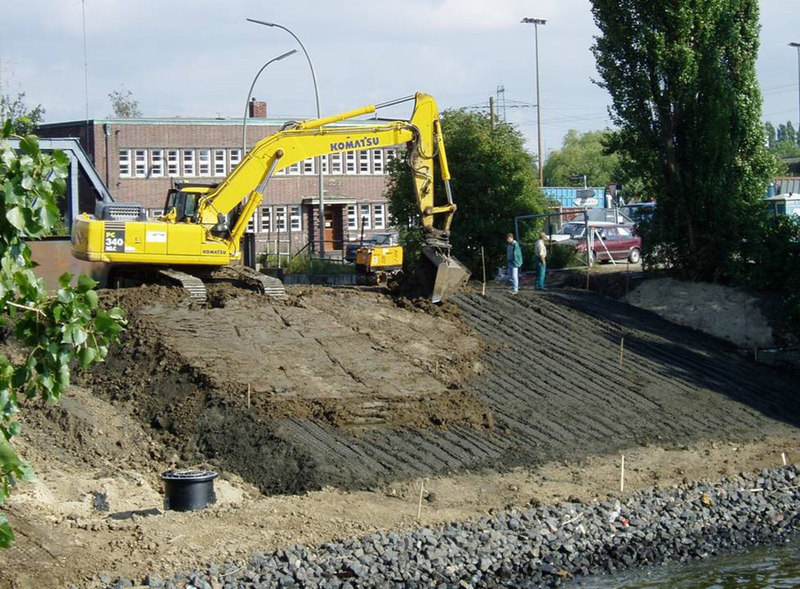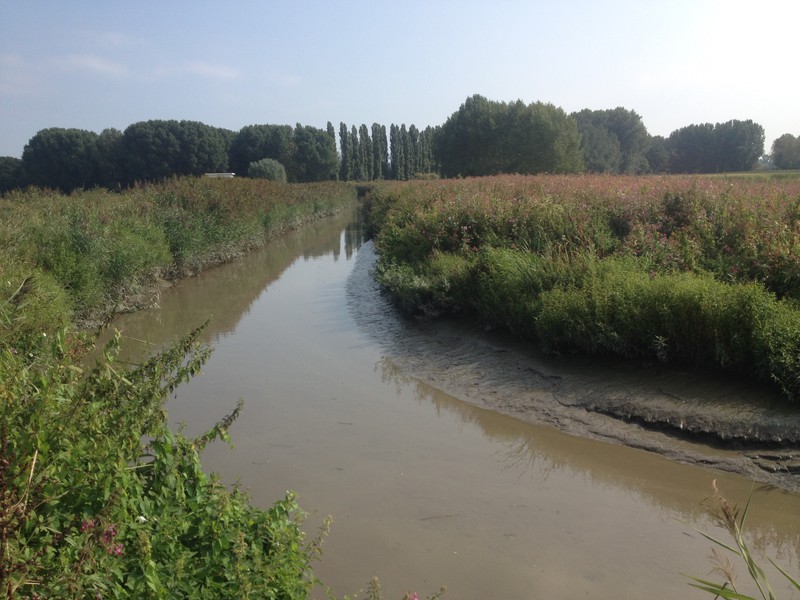The Case for Treated Sediment
Not a member yet? Learn about the benefits of membership

Photo of pilot dike construction using METHA Material below a layer of natural marsh sediment in 2004. Photo by J.Gebert. (Source: Case Study Beneficial Use of Sediments)
CEDA’s industry-leading exploration of the use of sediments in 2019 established the environmental, economic and social benefits to reusing sediment as a resource. This has since allowed the industry to implement more sustainable operations while keeping pace with essential development and upkeep such as that of ports, harbours, shipping channels, and reclamation of land. Reuse of sediment can mitigate the costs of disposal while facilitating engineering use or environmental enhancement.
The CEDA Working Group on the Beneficial Use of Sediments (WGBU) was an essential forum for vital insights on this matter, with members noting that as the volume of available dredged sediments increases, its quality for use may vary depending on whether the contaminated sediment is technically suitable.
Drawing on information shared in 2019, CEDA has since formed a new Working Group on substances of possible concern in sediment in 2024 to assess potential risks and solutions. Members of the working group will seek information in line with EU regulations governing the use of contaminated sediments, as well as explore substances of possible concern other than PFAS3, their sources and pathways, and the extent of the impact that sediment management has on these pathways.
Understanding contaminated sediments
Although regulations on sediment quality standards or disposal are likely to categorise contaminated sediments as waste, the 2019 review of case studies made a compelling case for implementing sediments contaminated by low-level pollution. This offers a unique opportunity to establish new routes that retain the many benefits of reusing sediment, including contaminated sediment, while addressing ongoing challenges such as the costs of treating sediment, issues with availability, and ensuring regulatory and procedural steps for compliance are met.

The Durme River (Source: Case Study Beneficial Use of Sediments)
As an example, the Durme River Valley restoration project, which formed one of the 2019 WGBU case studies, De Vlaamse Waterweg aimed to renovate the controlled flood area “Potpolder IV“ Flemish flood protection program Sigmaplan for the river Scheldt estuary. Although dredged material from the river was to be repurposed for building material in the construction of new embankments, sediments in the Durme River were found to have high levels of heavy metals, TPH, PFAS, PAH, and PCB due to the presence of the textile industry in the region. The relatively small grain size and polluted nature of the sediment required a special installation to be designed and used at the construction site to treat the dredged sediment. Sediment was then separated into fine polluted sediment and coarser material that was used for the construction of the dikes. Contaminated sediment was then, depending on its properties, either treated onsite through dewatering, separation of the sand fraction, and landfarming or off-site, with sediment that could not be treated set aside for disposal.
The treatment and use of contaminated sediment are therefore determined by the properties of the material involved, whether it can be treated with available technologies and local demand for the material. Following this, the treatment technique is decided based on the site configuration, the nature of the contaminants involved (whether chemical or physical), treatment goals, purpose, and the regulations of the country/region. These can include chemical immobilisation, bioremediation, phytoremediation, thermal desorption, sediment washing, and sand separation as well as ex-situ high-temperature processing.
Additionally, since contaminated sediments are not universally defined, what is termed contaminated may vary regionally, require compliance with different regulatory requirements, and may be determined by the purpose of use. For example, salt is considered a contaminant in sediment if that sediment is to be used for construction purposes.
Luca Sittoni, Chair of the WBGU, points out that proposed solutions for the use of contaminated sediments must be within the regulatory framework of that particular country or region because it is the regulator who ultimately approves the project. Notably, while certain regulations may be outdated and not applicable in the current context, new evidence and recommendations from studies conducted by the 2024 Working Group can inform the industry and establish a unified voice to lobby for updated legislation. However, until such action is available, it is essential that our industry continues to comply with the application and legislation that defines the acceptable level of contamination parameters in the use of sediment.
The value of contaminated sediment
Cost remains a key concern for the dredging industry. Contaminated sediment requires treatment, making it seem less cost-effective in the short term when compared to clean sediment. However, treating sediment and ensuring its reuse has vital implications for the long term where inaction on this issue will mean significantly reduced availability of clean sediment, higher costs of treatment, and the larger environmental impact on natural habitats.
Treated sediment can also act as a natural filter, buffering the release of existing pollutants in the surrounding environment and ensuring that these remain contained and minimise the risk of further contamination. This could be of particular value in dredging projects that undertake to restore coastal areas or create healthy wetlands, assisting in preserving a healthy ecosystem. The reintroduction of contaminated sediment into positive use under carefully agreed parameters also establishes a waste reduction pathway for the dredging industry that consequently reduces landfill costs and environmental impact.
Treating contaminated sediment establishes further business opportunities for the dredging industry as it sets the groundwork for more sustainable cross-industry collaboration. It can act as a readily available and cost-effective source of building materials, reducing current reliance on energy-intensive traditional methods that have significantly higher greenhouse gas (GHG) emissions while also addressing ongoing resource shortages.
While traditional approaches to the reuse and treatment of dredged sediment are more frequently used, innovative and unconventional methods are being developed to reclaim contaminated areas or offer new opportunities for development. An example of one such opportunity is The Brownfields Economic Development Initiative (BEDI) which assisted cities in the redevelopment of abandoned, idled, and underused industrial and commercial facilities where expansion and redevelopment were burdened by real or potential environmental contamination. In this case, dredged sediment stabilised with cement, blast furnace slags, lime, and fly ash could provide structural and non-structural fill material.
As Sittoni says, the increased focus on environmental preservation and sustainability in the EU is likely to have financial and regulatory implications for the dredging industry in the near future. Investors, regulators, governments, and stakeholders across the supply chain have begun to prioritise ESG (Environment, Social, Governance) commitments, greater sustainability, and investment in research and development that supports reduced environmental impact.
Establishing measures that address the use of contaminated sediment now will ensure that dredging operations are not only in line with industry values, but also proactively institute industry-leading best practice guidelines that continue to promote sustainable and future-proof operations in line with long-term European Union (EU) objectives.
The next step
Perception plays a key role in the use of contaminated albeit treated sediment, per Sittoni. This can lead to missed opportunities to improve operations and advance sustainability. However, he notes that while the industry is cautiously advancing on the reuse of contaminated sediment, Working Groups at CEDA have made significant progress in establishing the benefits of reusing dredged sediment and creating a forum to share information and collaborate.
CEDA will continue to monitor how the recommendations involved are translating into action, assessing and evolving suggestions for best practice. Interested members are invited to join the Working Group on substances of possible concern in sediment.
While the advice given in this editorial content has been developed using the best information available, it is intended purely as guidance to be used at the user’s own risk. No responsibility is accepted by CEDA or by the Intent Communications Ltd or by any person, firm, corporation or organisation who or which has been in any way concerned with the furnishing of information or data, the compilation, publication or any translation, supply or sale of this Guidance for the accuracy of any information or advice given herein or for any omission herefrom or from any consequences whatsoever resulting directly or indirectly from compliance with or adoption of guidance contained therein even if caused by a failure to exercise reasonable care.